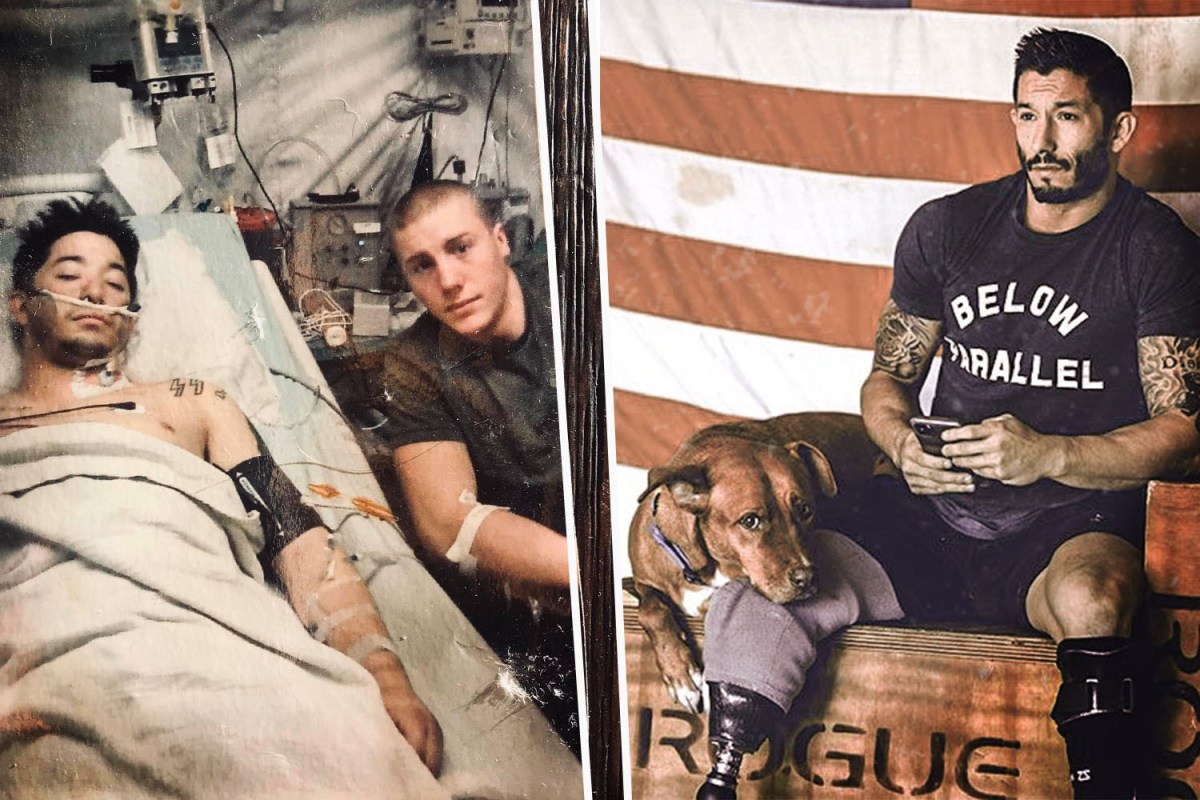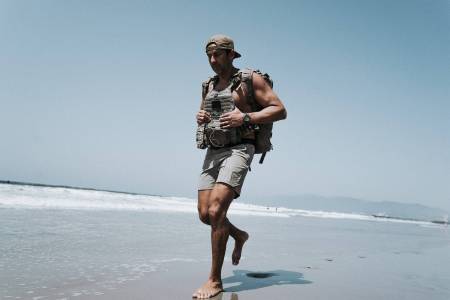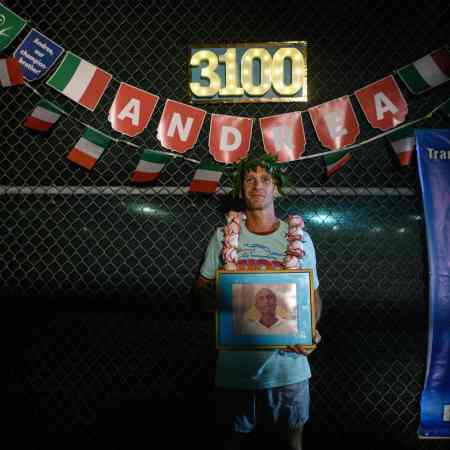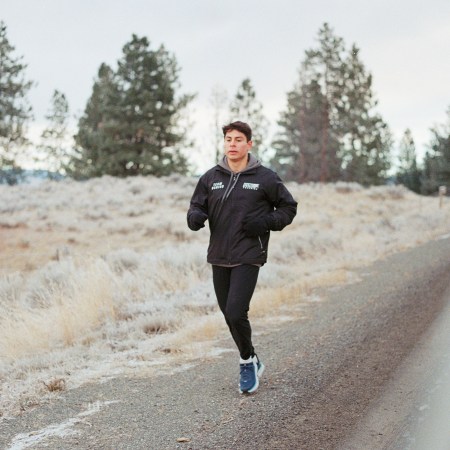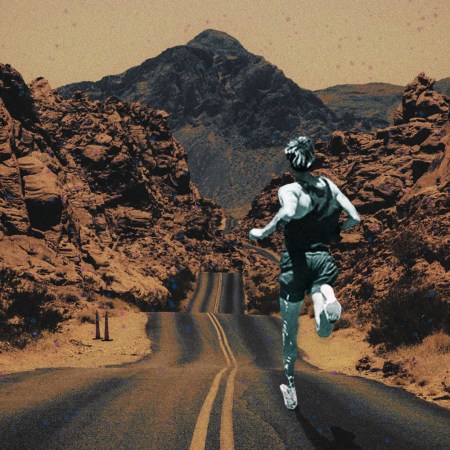Corporal Nick Perales lost his leg in an IED explosion while deployed on his second tour overseas. Despite multiple intensive procedures, the Marine Corps Recon Sniper was bound to a wheelchair for nearly a year and sank into a bout of depression. Eventually, with motivation from his Marine brothers and state-of-the-art prosthetics, he got back on his feet.
These days, Perales is back doing what he’s always done best: inspiring those around him and taking on big challenges. His latest challenge is a 205-mile endurance walk from Houston to San Antonio…with a 50-pound rucksack on his back. In partnership with C4 and Wounded Warrior Project, Perales intends to make it to Center for the Intrepid by Veterans Day. Below, Perales shares the long journey of self-discovery that started in Afghanistan’s Helmand Province, and will accompany him as he marches through South Texas.
It was February 2, 2011, and I was on deployment in Helmand Province, Afghanistan, with the Marine Corps Recon Snipers. My team, called Stalker Two, was assigned to find an unknown enemy that was placing roadside bombs along a patrol route that was frequently used by coalition forces. A few days earlier, they’d found a massive IED bomb alongside this road.
Our mission was to find out who was placing these bombs and take them out. We’d spent days doing reconnaissance on the terrain and making our plans. But now it was time to get on the ground and see what we’d be able to catch on site. I was inserted into the area with three other team members around 9 p.m.
Our gear for this mission was lighter than usual. We had our rucksacks with normal loadouts, which were different for each of us depending on our roles in the team. I was the point man and assistant team leader. We also had our radio guy, and our slack man who carried around our automatic weapon, the SAW. I was carrying my long gun, the M40A5 sniper rifle, along with the M4 and a pistol, which we all had.
On arrival, it was clear that there wasn’t a great area for us to set up and look over the road like we wanted. The hill that had the best view didn’t have much vegetation or other concealment, which meant we’d have to dig a hole to camp out in. We call those holes belly-scratch hide, and we needed it to be deep enough for four grown men. That was going to be no small feat.
Since we didn’t want to leave any indication that we were there, every chuck of dirt that we dug out of the ground had to be dumped in a river that was nearby. It was a tedious process. On the other side of the road there was some brush that we used to tie into our ghillie suits and place on top of our hole, along with a tarp to help conceal it.
It wasn’t until around three in the morning that we had a hide that wasn’t obvious to the naked eye. That’s when it started raining. I was with my teammate Bibbs on the other side of the road when we decided that we were done and it was time to head back to the camp to begin our observation period. I took a step towards our hide, and I stepped on an IED.
I was being thrown through the air, seeing this bright light, when I realized that I’d stepped on a bomb. The first thing that I did when I landed back down on the ground was call out to my teammate Bibbs, who had been right there next to me. I was afraid that the blast had killed him, but hearing him call back out to me was the biggest sigh of relief.
I started to try to understand what kinds of injuries I had sustained. My left leg was blown off at the site and my right leg was blown off at the knee. There were multiple severe open fractures. My tib and my fib were pointed out towards the left. My pelvis had open fractures, as well as my hands. The crazy thing was that my hand hurt the most out of everything, it was throbbing. I tried to grab my gun and the pain was too much.
From there it turned into a game of Marco Polo in the dark, where Bibbs was calling out to find where I was. I was actually the team medic, so when he got to me I told him I needed tourniquets as soon as possible. Unfortunately the tourniquets I had on me had been blown out of my pockets. So I instructed him to take off our belts and wrap them around my legs, using sticks from the ground to tighten up the wraps.
The rest of the team came across the river to set up security around me from any enemies that might try to approach. From there I was just laying on the ground, and it was a waiting game for the helicopter to come pick me up. It felt like an eternity, and shock started to set in. My legs felt like they were on fire and my upper body felt like it was freezing.
The command was saying that the air was red, which meant that there was too much risk for air attack on the medevac, so they couldn’t get to me. I started to believe I was going to die there. The time was just moving so slowly. Seconds were feeling like minutes and minutes were feeling like hours. It was just me and my three guys, waiting to see if I was going to survive.
The medevac helicopter crew eventually said just screw it and they took off without a gunship, which is not the protocol, because they didn’t want to leave me stranded. They took off to get me despite the risks. They landed on the sand hill across the river and the team carried me in a poncho over onto the helicopter. Once we were up in the air, that’s when I passed out.
Navy SEAL Kaj Larsen’s Guide to Becoming a Better Swimmer
The best waterman in his class talks dolphins, breath exercises and something called “surf torture”I only have a few sporadic scenes in my memory from those days after I got on the helicopter. The first one I don’t even really remember, but was told after the fact. There’s a photo of me in the hospital bed in Afghanistan with Bibbs sitting next to me. Bibbs told me that the first thing I did when I woke up was ask him if I still had my balls. He said, “Yeah man, I already checked!” I couldn’t stop laughing when he told me. That was just the kind of teammate that he was.
There were a few flights after that, including one back to the States where I was being brought to Bethesda, Maryland. I remember that being a shitty flight, where I was cuffed down to the bed with all these tubes going into my body while they were doing procedures. I was moved to San Antonio, Texas, because my family wanted me as close to them as possible as I was recovering, even though the military suggested keeping me in Maryland.
I was actually conscious about what was happening around me two weeks later in that hospital. That’s when I first started to process the severity of what had happened. Being the point man on the team, I was always aware that there was a possibility that I could step on an IED. I accepted the fact that if I stepped on a bomb, I stepped on a bomb. I knew that if it came to it, and I survived, then I would be able to come back. I always believed that about myself. But that didn’t make what followed any easier.
The room was constantly filled with doctors that were pumping me with all kinds of drugs and doing all these really extensive procedures on me. I remember being in this hospital bed and just feeling hopeless. I had to rely on everyone else to do basic shit for me. I couldn’t even wipe my own ass. For a man and a Marine, it was a lot to deal with mentally. I’ll be honest, there was a period in which I fell apart and lost sight of who I was. I was using the narcotics that the hospital was giving me to escape the pain but also to escape life. I was drinking myself to sleep every night. I was bound to a wheelchair. This went on for almost a year.
On my darkest day, I was lying in my hospital room alone when I took the sheets from my bed and wrapped them around the bar above me. I used the sheets to pull myself up and tied the other end around my neck. I just though, “Fuck this shit.” I wanted to die, so I rolled off the bed. Thankfully, a nurse saw what I had done, rushed in and cut the sheet off. She saved my life, and I’m very grateful for her.
I still continued to struggle after that, though. There was a lot of darkness, but I learned a lot of great things about myself during that time too. My team of Marines were the ones that finally pulled me out. One of the first steps I took was going to the Marine Corps birthday, and I was getting into my dress blues. I looked at myself in the mirror and I didn’t like what I saw. I had been eating like an asshole in the hospital, using all of this trash food as another escape.
The final straw was that I couldn’t get the collar of my old uniform to close, because over the that year I had gone up to around 240 pounds. That was about 80 pounds heavier than I had been before the bomb. No matter how hard I tried, I couldn’t close that collar and I was filled with this profound disappointment in myself.
Sure, I was injured, but there had been multiple people who had risked their lives to save mine, including that medevac team. Not to mention the doctors who had worked hours on putting me back together. I wasn’t doing any justice to their actions if I just faded away into the night. Doing right by their sacrifice became my motivation. That was my moment.
That day I took every pill in my cabinets and threw them in the trash. I went to my kitchen and completely cleaned it out of all of the junk food. I decided to go back to doing what I do best, and that’s being a Marine Corps sniper. The best of the best. I went back to living and fighting with a purpose. I was going to do everything I could to be a survivor and help keep those around me living their best life as well.
I didn’t have any guidebook on what a guy with my kinds of injuries should be eating or how he should be training. But at 5 o’clock in the morning I was the first person in the gym. I was there again at lunch time and there again at dinner. I was in a rehab center where I wasn’t the only veteran there missing limbs. I wanted to inspire the others and create impact amongst the Marines around me.
There’s one moment that stands out in my mind during that period. I was just starting to get into CrossFit after my injury and I competed in this event where I was the only wounded person on my team. There were limitations to what I could do, as I was in a prosthetic and I didn’t have an ankle. I’m a competitive person, and everyone around me was super serious about the challenges. I did well and then I remember one of the guys came up to me to say, “You’re really strong for someone missing your leg.”
I was pissed off, because I wanted him to say I was strong in general, especially after I had just beat him. I didn’t want anyone paying me any compliments if they came with the qualification of “for someone who is missing your leg.” The next day I was doing a huge strength program, and I focused on never having someone doubt me again. I was never going to be weak again.
I tried every diet that I found information on, from paleo to intermittent fasting. I continued to push myself hard in the gym as well. I went back down to 160 pounds from 240 pounds in four months. People were impressed. I found that I was doing exactly what I wanted to to inspire those around me. I decided to keep upping the ante and started to look for challenges that I could do to engage and support people around me.
This year I’m doing my biggest one yet, walking 205 miles from Houston to San Antonio while carrying a 50 pound rucksack on my back. I’m partnering with C4 Energy, which I’ve used throughout my journey, in support of their work with the Wounded Warrior Project. I was blown away by the fact that they donated half a million dollars to the WWP.
The rucksack I’m carrying represents the weight carried by all of our nation’s heroes, and that’s what I’m going to be thinking about as I shoulder it. I’m packing it with an old American flag, a Wounder Warrior Project flag, that photo of Bibbs and I in Afghanistan, plus all the supplements I’m going to need throughout the day. I’ll also have a plate carrier that will add about 25 pounds to the load.
There’s always a plan and there’s always another plan for when that plan doesn’t work. I have the whole route mapped out. I’m going to be doing 20-mile days, give or take, depending on the situation. I’ve had a brand new prosthetic made for this particular journey, which is always a little nerve-racking. I’ve broken a few prosthetic over the course of some challenges that I’ve done, but I have a backup just in case.
Everything has evolved so much since I first started this fitness journey, and that goes for the prosthetics. I wear an IDEO brace that turns my left leg into a prosthetic. It’s carbon fiber that wraps around the bottom of my foot and puts all the pressure to my knee. I need it because my ankle is fused together and it’s kind of like a foot stuck to a leg without any movement. I’ve come a long way from back when I was wearing peg legs and could barely make it a mile.
The best part of doing a challenge like this is the unknown. It’s in these moments that I learn the most about myself. Once I step out that door nothing is certain, except for the fact I’m walking for 205 miles with 50 pounds on my back. No matter what happens, I’m going to arrive at the Center for the Intrepid on Veteran’s Day.
The Charge will help you move better, think clearer and stay in the game longer. Subscribe to our wellness newsletter today.
